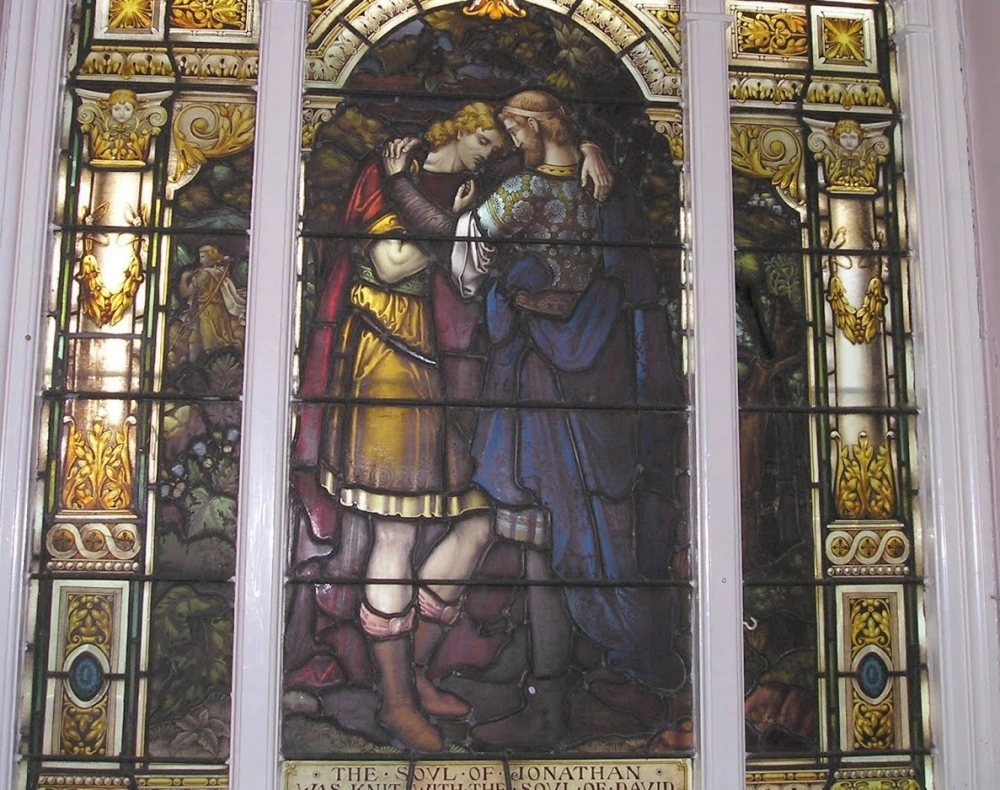Homosexuality, Bisexuality and Homosociality may heighten coherence among Jewish men. Yet these developments may, in addition, be an alliance-forming adhesive vis-à-vis Aryan men, whether in the Religious or “Secular” context. Hence it may facilitate both an ability to cohere internally as well as an ability to cohere to the host.
Here the relationship between the Jewish David and the Aryan Jonathan is also worth briefly revisiting. Indeed, this “Homosocial” relationship is an honored motif in Medieval and Renaissance art and apparently, now, a favorite among open “Catholic Homosexuals.” The latter is truly a category we should be unsurprised to find.
When Jonathan met David it was love at first sight, at least on the “platonic” level, though it seems obvious more is suggested. The Hebrew Bible says:
“Now it came about when he had finished speaking to Saul, that the soul of Jonathan was knit to the soul of David, and Jonathan loved him as himself [1] […] Then Jonathan made a covenant with David because he loved him as himself. Jonathan stripped himself of the robe that was on him and gave it to David, with his armor, including his sword and his bow and his belt. [2]”
The covenant here, which in Judaism is never far removed from the notion of circumcision and emasculation before a Jewish God, is suggestive. Suggestive as well is Jonathan’s striping and the relinquishing of weapons that are readily understood as phallic symbols. As this study discusses, bow or qastow, קַשְׁתּ֖וֹ, in other instances, such as when the Jewish God is suggestively standing behind and holding the archer Joseph in Genesis 49:24, may suggest “bending” and sodomy. Here, as this study discusses, Joseph is indicated as an Aryan. Indeed, strategic bisexuality on David and Yahweh’s part is suggested here as a power seeking strategy.
When King David laments Jonathan’s death, which clears David’s path to the throne, he cries: “I grieve for you, Jonathan, my brother. You were delightful to me; your love to me was extraordinary, surpassing the love of women. How have the mighty fallen, And the weapons of war perished.” [3] Here the Hebrew word meahabat, מֵאַהֲבַ֖ת, is used. It translates in the modern Hebrew as “lover,” “mistress,” and “concubine.” It’s clear here who is “top” and who is the “woman.”
By the way, this death scene is a classic example of “The Melancholy of the Shohet.” Indeed, the phrase “how the mighty have fallen,” a repeated phrase in the Book of Samuel, has commonly been used in the English language as a kind of triumphant mockery of fallen adversaries.
While the parable does, through JEM, suggest actual homosexuality, even a message of “platonic love” between Aryan and Jew, particularly as it is described here, is deleterious. Consider for instance the number of Aryans at this precise moment whom have Jewish friends, whom would never criticize the Jewish right to a homeland or desire for genetic continuance, yet would never dare suggest that their own group deserves the same right. That is “homosocial.” That’s called being a “bottom.” The JEM identifies this while Jews deny it and “homosocial” Aryans live in denial.
Read Part VII of this series here: Homosexuality Part VII: The Aryan Jonah and the Pederastic Synagogue

[1] Book 1 of Samuel 18:1
[2] Book 1 of Samuel 18:3-4
[3] Book 2 of Samuel 1:26-27
2 thoughts on “Homosexuality Part VI: David & Jonathan: The Homosocial Love between Jewish and Aryan men”